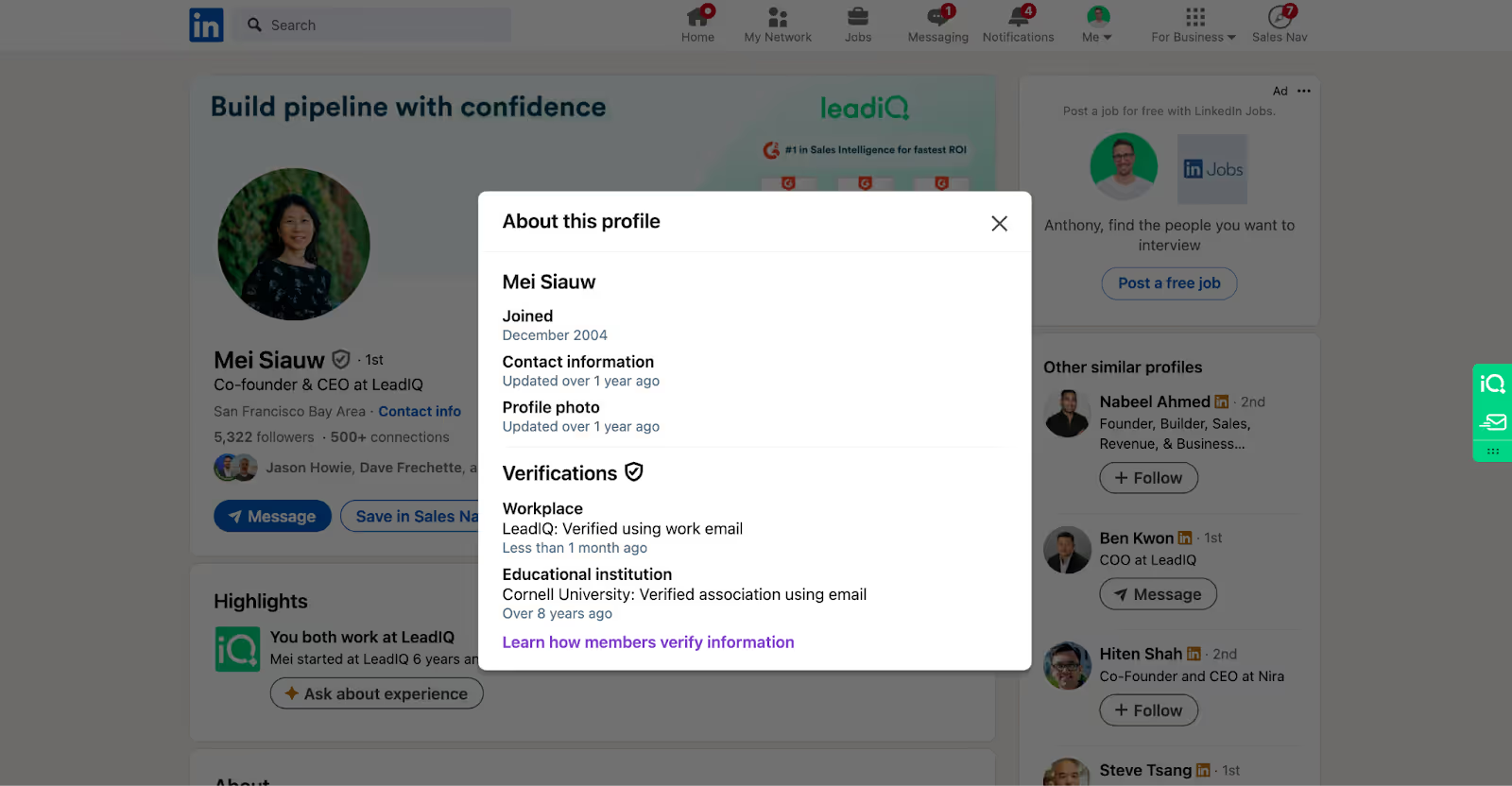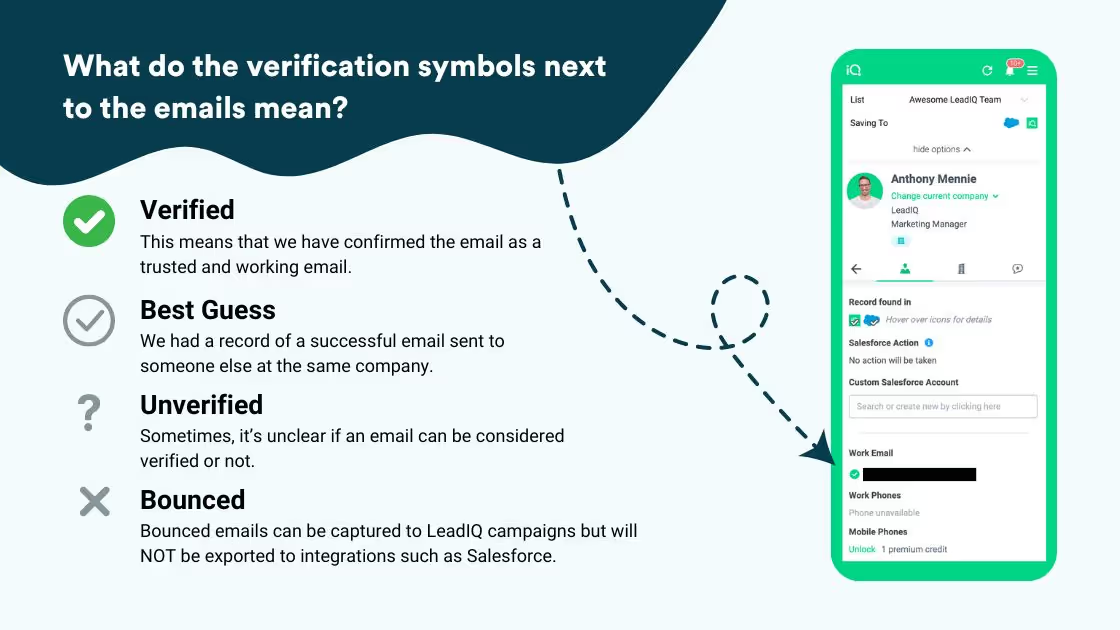Ready to create more pipeline?
Get a demo and discover why thousands of SDR and Sales teams trust LeadIQ to help them build pipeline confidently.



Every sales rep faces objections on a regular basis; it’s how you respond to those objections that separates top sellers from the rest of the pack

Many of these objections are common, and you’ll encounter them over and over again as you move through your career

By preparing for common sales objections and knowing what you can do to overcome them, you can build trust and win more business
Get a demo and discover why thousands of SDR and Sales teams trust LeadIQ to help them build pipeline confidently.
To close more deals, SaaS sales reps need to do everything they can to enhance their credibility and trustworthiness in the eyes of customers and potential prospects.
In a field where building strong relationships and developing trust is essential to success, verified profiles assure prospects that sales reps are legitimate and represent a real organization — and vice versa — which can lead to more successful connections and higher response rates.
Since SaaS sales reps typically hang out on LinkedIn all day, LinkedIn verification serves as a powerful tool they can use to establish authority, differentiate themselves from fraudsters, and otherwise bring confidence to their outbound prospecting efforts. At the same time, they can also use it to determine whether prospects are who they say they are.
Keep reading to learn more about what LinkedIn verification is, why it matters, how to verify your profile, and some concerns to keep top of mind as you go through the process.
LinkedIn verification is a feature designed to authenticate the identities, professional affiliations, and academic credentials of users on the platform. After a user verifies this information, a verified badge appears next to their name on their profile.
LinkedIn verification can be a powerful tool for sales teams, ensuring rep is who they say they are and fostering trust in their interactions.
One key benefit of verification is the confirmation that you’re talking to the right person. In an era where bad actors frequently spoof employees and high-level executives, having a verified LinkedIn profile can significantly reduce the risk prospects fall victims to such scams. Verification helps prospects feel confident that they’re engaging with genuine sales reps from legitimate companies — not impostors trying to exploit them.

When prospects receive outreach messages from sales reps, they often examine the sender’s profile to gauge their credibility. A verified profile provides immediate peace of mind, assuring prospects they are dealing with a real person. This credibility is critical for establishing trust early in the sales process, which can significantly influence a prospect’s willingness to engage in further discussions.
Additionally, LinkedIn verification enhances a sales professional’s personal brand, demonstrating their commitment to transparency and authenticity. It also differentiates them from competitors who may not have verified profiles, giving them a distinct advantage in building rapport and trust with potential clients.
By pursuing LinkedIn verification, reps can build more reliable, trustworthy relationships — ultimately leading to better sales outcomes.
For sellers, the benefits of LinkedIn verification are obvious. In this section, we walk you through the steps you can take to verify your identity and workplace on your LinkedIn profile.
Kick off your LinkedIn verification efforts by confirming you are who you are. To do this:
Looking to verify your workplace on LinkedIn? Here’s what you need to do:
Privacy concerns about LinkedIn verification are valid, and some privacy-conscious individuals might hesitate to provide identification to LinkedIn and its partners. After all, sharing personal identification documents can feel invasive. In today’s age of seemingly endless data breaches, it’s not uncommon for folks to be concerned about data security and how sensitive information might be stored.
On the flipside, buyers are often thoughtful about the networks they build and who they connect with. Even when someone is verified, buyers should critically evaluate connection requests and consider the potential risks of sharing personal information with new contacts. By staying cautious, buyers can help mitigate privacy risks and ensure a more secure network.
Understanding these concerns, sellers should be mindful in their cold outreach. For the best results, reps need to steer clear of spammy practices that can hurt their reputation. By taking the time to craft thoughtful, personalized messages that respect the recipient’s privacy and time, sellers can form more meaningful connections while avoiding the negative connotations associated with unsolicited outreach.
Add it all up, and by balancing the benefits of verification with the respect for privacy, buyers and sellers can both create a more trustworthy, secure, and productive LinkedIn (and buying) experience.
Not seeing a verification badge next to a prospect’s name on LinkedIn? All hope isn’t lost. You can still make sure the folks in your network are legitimate people using these two methods.
When LeadIQ finds a business email, our platform sends a request to the company’s server, resulting in a yes or no answer. When we get an affirmative response, we mark the email “verified” and put a green checkmark next to it, indicating the address is 95% likely to be accurate.
Using LeadIQ, you can optimize email deliverability rates, avoid ending up as spam, and otherwise protect your domain.

Want to make sure you’re reaching out to the right people? Only import verified emails and contact data to LeadIQ to build a reliable digital rolodex filled with folks who are actually real.
By doing so, you can ensure you’re powering your prospecting workflows with reliable data — and get better sales outcomes because of it.
As a seller, you should probably go ahead and get yourself verified on LinkedIn. It’s an easy way to prove to prospects you are who you say you are, right out of the gate.
But not everyone wants to give up personal information, so some legitimate prospects might not be verified on LinkedIn. Not a problem — it still may be possible to confirm their identities.
To learn more about how LeadIQ can help you get better results from prospecting, book a demo today.